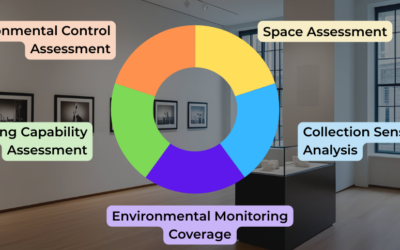The design and implementation of appropriate museum lighting is a crucial element of both collections care and curatorial decision making. In this blog post, we will talk about the use of natural and artificial light sources in museum lighting design. By understanding the characteristics of these two light sources, we hope to enable you to make more informed decisions about your institution’s lighting strategies and potential options.
What are the implications of using natural light in museum lighting design?
Natural light, with its dynamic range of color and intensity, can enhance the aesthetic appeal of exhibits. At its best, it can create a pleasant and inviting atmosphere in an inside space as well as provide a high level of visual acuity and color rendering. Its use can be associated with both positive and negative behavioral and physiological responses in visitors. Its variability through time can create a sense of movement, change, or connection with outside nature from the inside of a building and even change the ways in which visitors interpret the artwork.
However, natural light is not without its challenges. It is naturally variable and uncontrollable, making it difficult (and expensive) to maintain consistent lighting conditions. Think about how light changes based on the time of day, season, weather, and orientation of your building – and then try to make a plan for lighting a gallery taking all of these variables into account.
Certain museums around the world that have decided to use natural light in their spaces rely on diffuser layers or internal systems of blinds that move throughout the day and control light level meticulously (Read more about them here).
The primary concern when using natural light in museums is potential damage caused by ultraviolet (UV) and infrared (IR) radiation, which can lead to the fading and degradation of artifacts. To mitigate this, museums employ UV-filtering glass and adjustable blinds to regulate sunlight exposure. If you’d like to read more about natural light management in historic properties, don’t miss this free PDF “Managing Natural Light in Historic Properties” by David Thickett.
What about sustainability? This will depend. Natural light will, of course, mean you are not using electricity to light your exhibits. However, if you are implementing engineered mechanical systems of blinds or diffusers to manage this varying light source throughout the day, it might end up being just as high-maintenance if not worse. If, instead, you rely on simpler UV filters and physical obstacles (such as walls) to bounce light around a space, then you would only need to use your artificial lights when the natural light is not enough.
How does artificial light compare in museum lighting design?
Artificial light sources will provide you with a level of control and consistency that natural light does not. With the improvements of LED lighting technology in the past few years, it is now possible to choose color temperature, color rendering index, and intensity of bulbs to mimic daylight indoors. Having a combination of different bulbs in the same space makes artificial lighting a flexible option for museum lighting design.
While LEDs have been praised for having low or inexistent levels of UV and IR, not all artificial light sources are created equal when it comes to the potential for causing damage to exhibits. If you’d like to read more about the specifics of artificial lighting in museum settings, check out our post on Balancing Light Levels in Museums & Preventive Conservation Goals.
Don’t forget that regardless of whether you use artificial or natural light in your museum lighting design, it will be important to make sure you measure it. Bad quality bulbs and/or excessive natural light may cause problems such as glare, temperature hikes, and color distortions which will affect both the conservation of your objects and the visitor experience.
Is there a middle ground between natural and artificial light sources?
Certainly. Many museums find that a combination of natural and artificial light results in the most effective museum lighting design. This hybrid approach allows for the aesthetic benefits of natural light while also ensuring consistent and controllable conditions. Here are some examples:
- The Yale Center for British Art uses a mixture of unfiltered daylight, diffused natural light, and artificial lighting depending on the space.
- The National Gallery (UK) uses natural light supplemented by a range of artificial illumination units that turn on and off automatically depending on the quality of the natural light.
- The National Gallery of Art in Washington, DC filters and diffuses natural daylight from its skylights and complements it with artificial lighting.
- The Kimbell Art Museum (Fort Worth, Texas) uses a fascinating mix of diffused natural daylight and artificial spotlights for a striking effect.
If you are interested in reading academic studies on the use of daylight in museum settings, check out this open access article: An evaluation of daylight distribution as an initial preventive conservation measure at two Smithsonian Institution Museums, Washington DC, USA. Del Hoyo-Meléndex, Mecklenburg / Doménech-Carbó, 2010.
Both natural and artificial light sources may have their place in museum lighting design. Museum administrators, collections care, and curating staff will have to balance the needs of the visitors, the objects on display, and the institution’s energy bill. As you have seen, there are both advantages and disadvantages to each kind of lighting system, so choosing between them or integrating them will require careful consideration of several factors such as aesthetics, conservation goals, visitor comfort, and energy efficiency.
Want to read more about museum lighting?
Don’t miss our posts on Choosing Museum Lights for Paintings – 7 Aspects To Consider and Museum Lighting Guidelines – 7 Open Access Articles To Help Your Collection.
If you have any questions about environmental monitoring, integrated pest management, or just want to talk about preventative conservation, please reach out to us! Don’t forget to check out our blog or join our community of collections care professionals where you can discuss hot topics, connect with other conservators or even take a course to get familiar with the Conserv platform.




